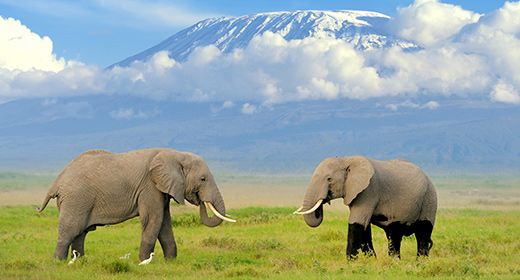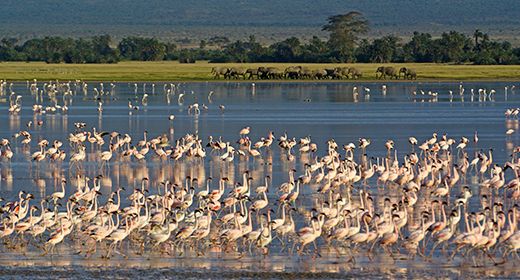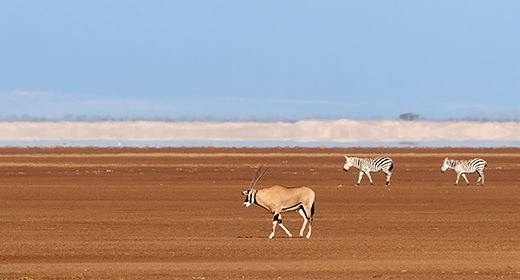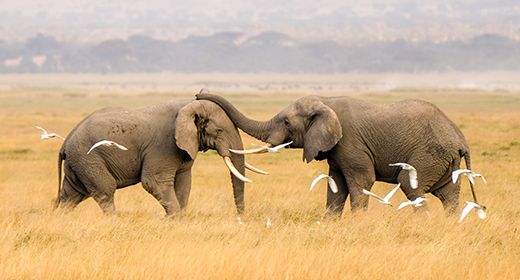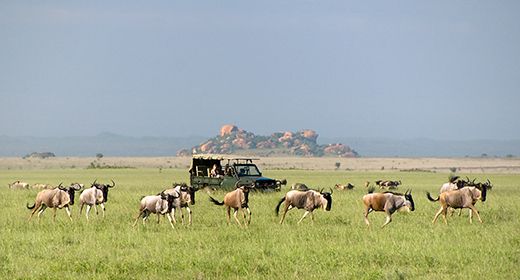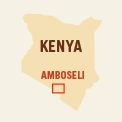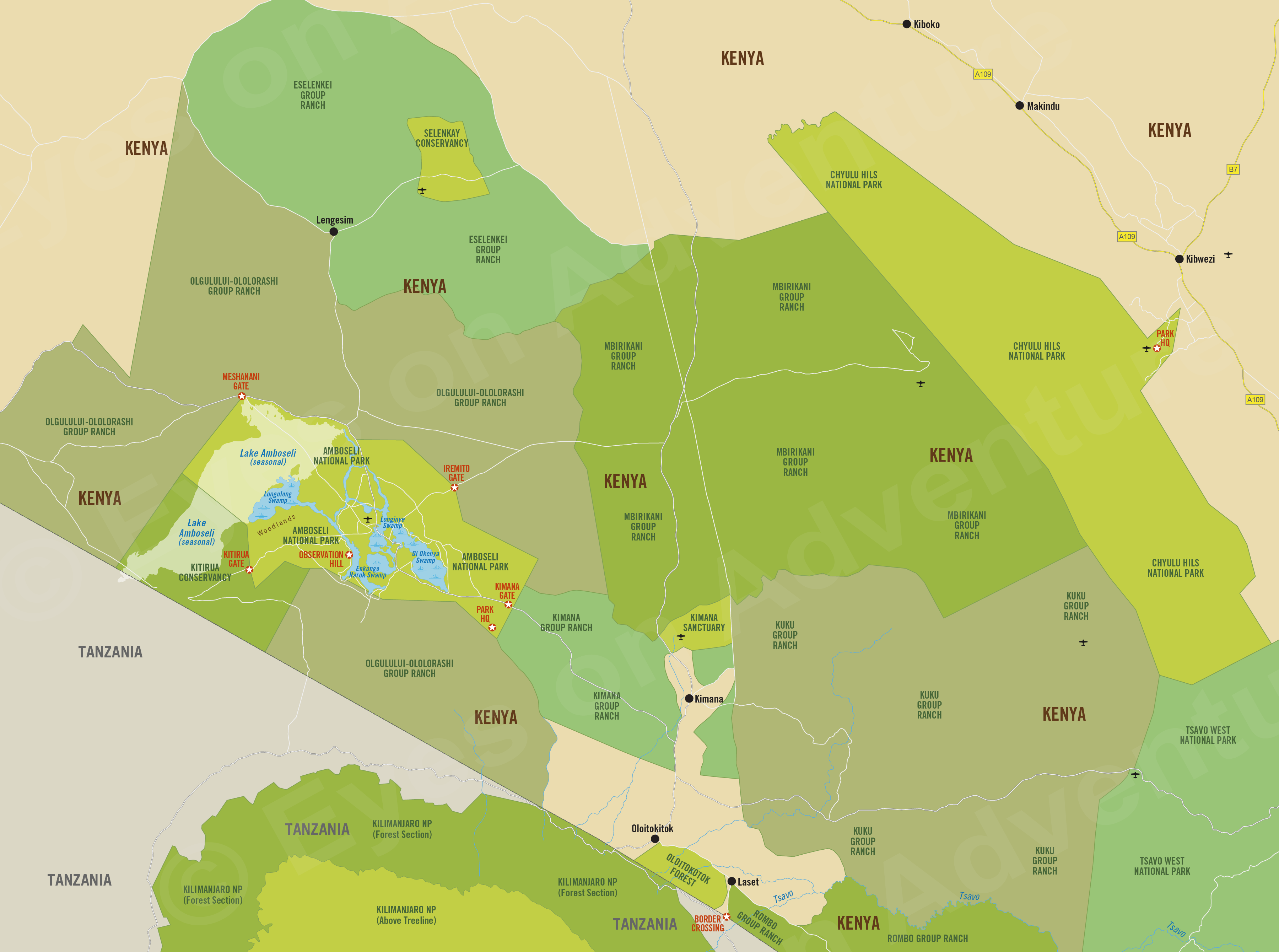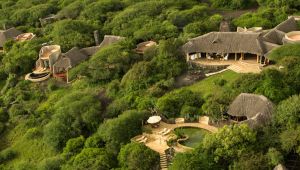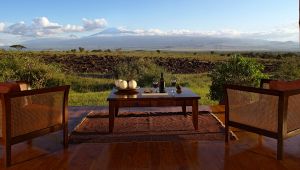Amboseli & Chyulu Hills
(incl. Selenkay, Kimana, Mbirikani, Kuku)
Region Links: Amboseli & Chyulu Hills, East Coast Kenya, Great Migration, Laikipia, Masai Mara, Nairobi, Rift Valley & Central Highlands, Samburu, Tsavo
Highlights
- Amazing views of Mount Kilimanjaro on clear days.
- Extraordinary elephant viewing in the national park.
- Outstanding photography year round, but especially in the dry season.
- Game drives, horseback riding and mountain biking in the lovely Chyulu Hills.
EOA Recommends: Campi Ya Kanzi, Ol Donyo Lodge, Porini Amboseli Camp, Tortilis Camp
The Amboseli region is a bridge ecosystem between Tsavo in the east and the Masai Mara-Serengeti ecosystem to the west. This is the spectacular home of Amboseli National Park, which name derives from the Maasai word for "place of dust".
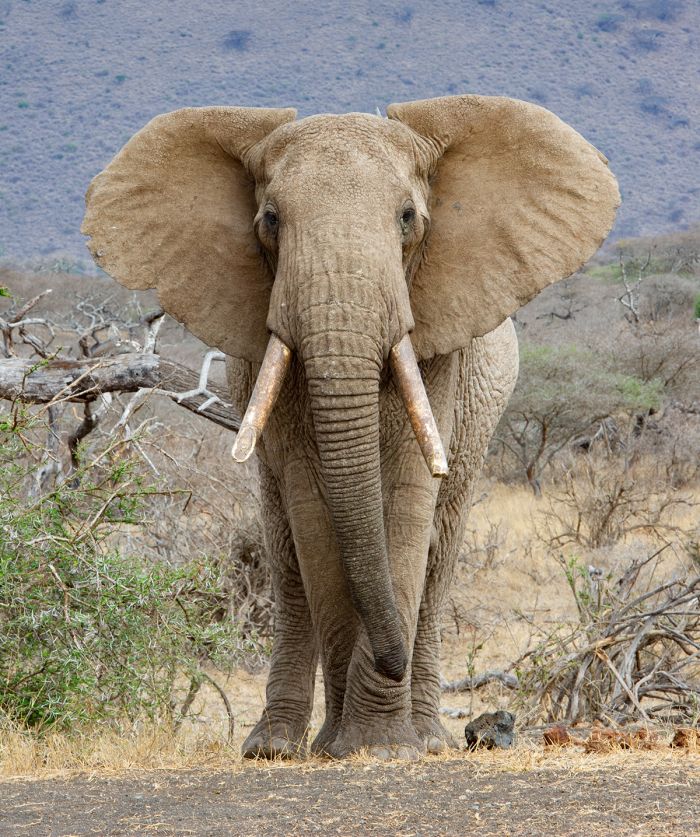
A beautiful bull elephant in the Amboseli region (copyright © James Weis).
Amboseli is set against the backdrop of Mount Kilimanjaro, located just across the border in Tanzania and the highest peak on the African continent. The seasonally wet Lake Amboseli and the surrounding swamps combine with the vast open spaces, savannas, and woodlands to create a dynamic ecosystem unlike any other in Africa.
Amboseli is perhaps most famous for its elephants, which are here in abundance. The sight of herds walking through the arid landscape with Kilimanjaro as a backdrop is almost too beautiful to believe.
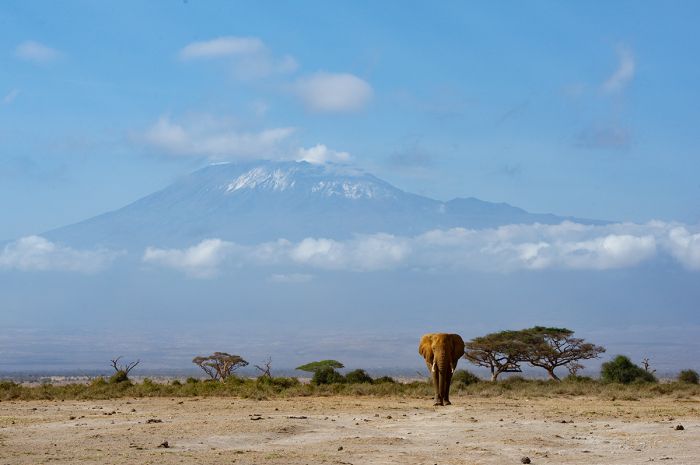
An elephant in Amboseli with Mount Kilimanjaro (copyright © James Weis).
Northeast of Amboseli are the Chyulu Hills and the national park which protects the beautiful landscape and wildlife that lives there. Chyulu is one of Kenya's least visited reserves and also one of its most scenic. Chyulu's wildlife is diverse and activities include game drives, horseback riding, and hiking to the cloud forest.
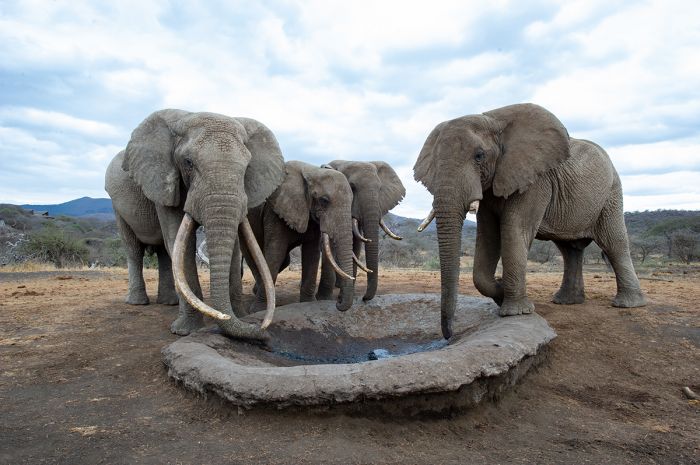
Elephants at a waterhole; Ol Donyo Lodge, Chyulu Hills (copyright © James Weis).
The small but game-rich Selenkay Conservancy is one of Kenya's conservation success stories. Walking safaris with knowledgeable Maasai hosts are a highlight.
The lands east and north of Amboseli are sparsely populated, with no large urban areas. The land is partitioned into parcels called "Group Ranches" and there are safari camps and various conservation initiatives throughout the region.
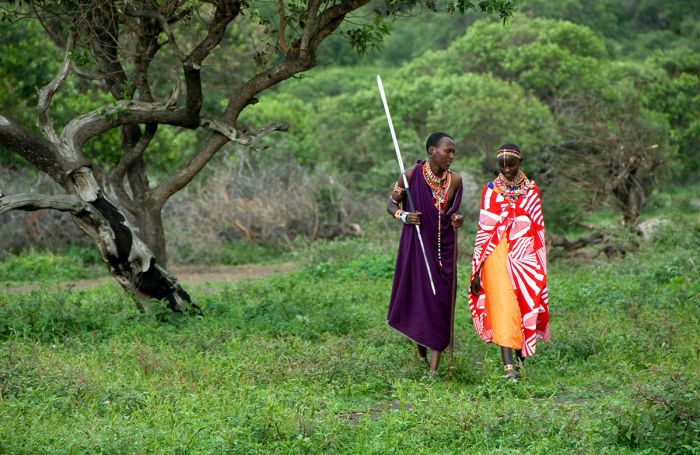
Maasai people in the Greater Amboseli region.
Read More...
Amboseli National Park, Amboseli Trust for Elephants, Chyulu Hills, History, Selenkay Conservation Area, Wildlife
history
The current national park is part of what was historically the Southern Maasai Reserve, created at the end of the nineteenth century. Tourism started in the 1940's and Amboseli was given protected status as a reserve in 1948.
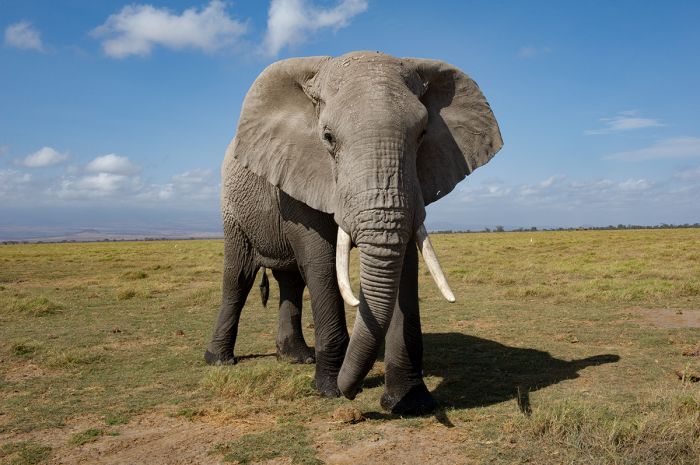
Bull elephant in Amboseli National Park (copyright © James Weis).
The swamps in Amboseli had long been used by the Maasai people to water their cattle and they continued to do so even after the reserve was created.
Unfortunately, the increased demands on the water in the reserve created an unsustainable situation, with tourism, wildlife and the Maasai cattle all competing for the limited supply in the reserve. As a result, much of the acacia woodlands died off during the 1970's. The Kenya government declared the area a national park in 1974 and this meant that the Maasai (and their cattle) were formally excluded from the park.
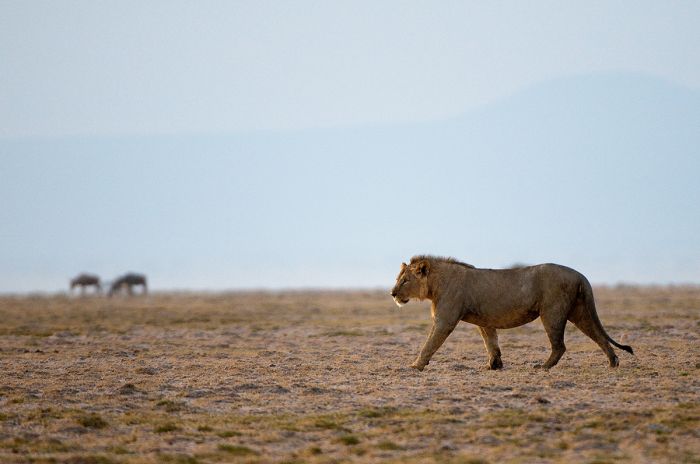
A male lion crossing the dry plain in Amboseli National Park.
In retaliation, the Maasai killed nearly all the park's black rhinos (Amboseli's emblematic animal and a major draw for tourists) over the following three years. The few remaining rhinos were captured and translocated out of the park. The Maasai also wiped out the majority of the lion population, which has still not recovered today.
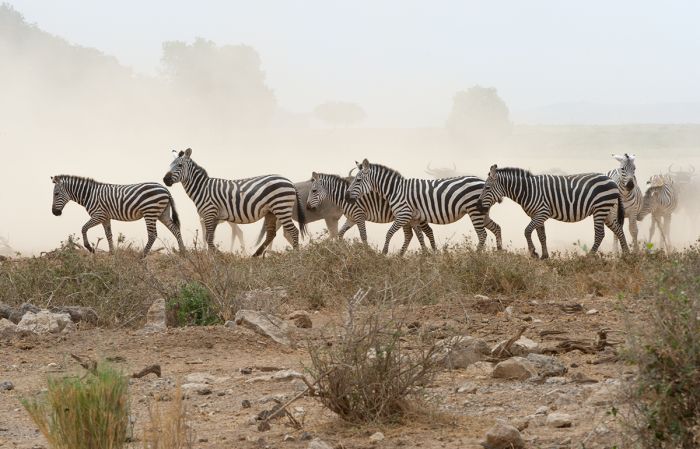
Burchell's zebras in dusty Amboseli conditions (copyright © James Weis).
The conflict continued until a dedicated water pipeline was built for the Maasai cattle, after which the Maasai gave up their land. Today there seems to be an unofficial compromise, as during the dry season, Maasai herders and their cattle can still be seen encroaching inside the park, as in the old days.
Amboseli's grasslands were badly degraded by uncontrolled tourist minibuses during the 1980's, creating a vast dust-land that was inhospitable for the wildlife. A dedicated effort to build roads and restrict tourist numbers, as well as strictly prohibiting off-road driving has greatly improved this situation.
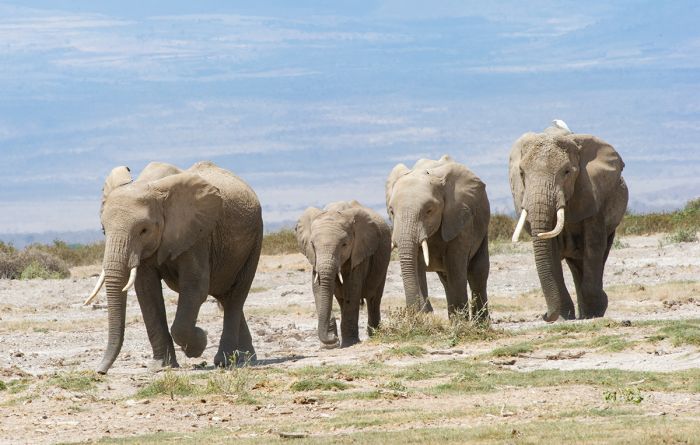
A small elephant family in Amboseli National Park (copyright © James Weis).
amboseli national park
Covering 151 square miles (392 sq kms), Amboseli is often called the 'Maasai Place of Dust'. The national park contains diverse habitats, from open plains, acacia-thorn bush/scrub, large freshwater swamps and marshes fed by streams from Kilimanjaro, and acacia woodlands.
Most of the open plains in the park are covered with a fine, saline volcanic ash that was deposited by successive Kilimanjaro eruptions during its active period long ago. During most days, this volcanic dust becomes disturbed by wind and also by the hooves of the plains game, creating incredible imagery, especially at sunset. Huge 'dust devils', similar to miniature tornados, can be seen blowing across the plains during midday.
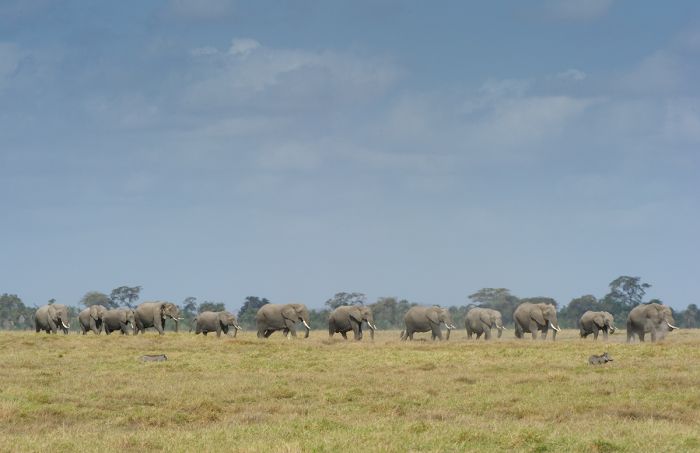
Elephants moving through Amboseli grassland (copyright © James Weis).
Given the dry and seemingly inhospitable landscape in Amboseli, one may at first wonder how so many animals can survive here. The answer is that water from the upper slopes of Kilimanjaro drains into Amboseli via a network of underground streams and resurfaces at its northern base, where they feed into a network of swamps and seasonal lakes in Amboseli.
The large Lake Amboseli in the west is usually bone dry, but when substantial rains arrive, the shallow lake retains enough water to attract flamingos and pelicans, and the entire area transforms from a dry and dusty lake-bed into a lush oasis for wildlife.
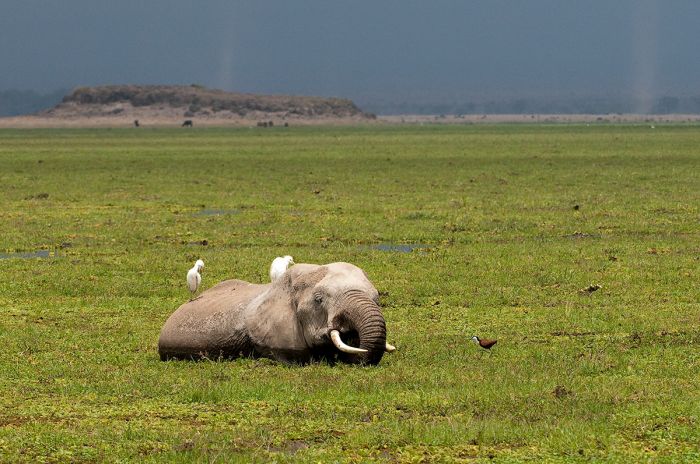
Enkongo Narok Swamp with Observation Hill in the distance.
The national park itself is small and can be somewhat crowded with tourists. That said, the amazing elephant herds and towering Mount Kilimanjaro as its backdrop combine to make Amboseli an incredibly scenic place to visit.
Kilimanjaro, as seen from the national park, is massive and fills much of the sky to the south, but is often shrouded in clouds at its upper elevations. Sunset and early morning are the best times to see 'Kili', and seasonally best during the rainy season, when the air has less dust.
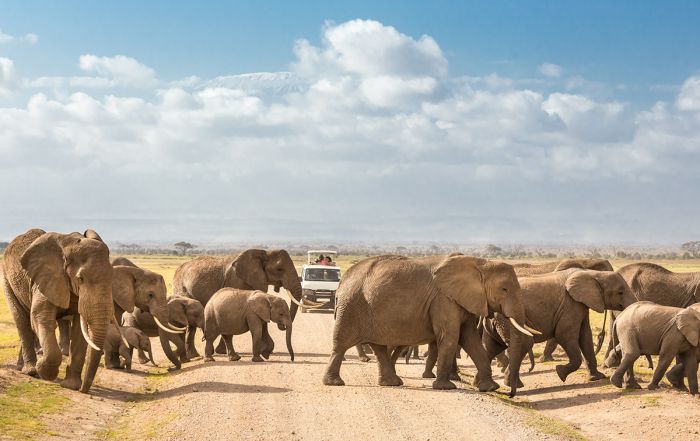
Elephants on the move in Amboseli National Park.
Amboseli Wildlife
Amboseli is a haven for hundreds of elephants and the herds are numerous and include many 'big tuskers'. The predators here are not easily seen, aside from the jackals and spotted hyenas. The once prevalent lions never recovered from historic persecution by the Maasai, and cheetahs are only rarely encountered. Leopards are present, but extremely elusive.
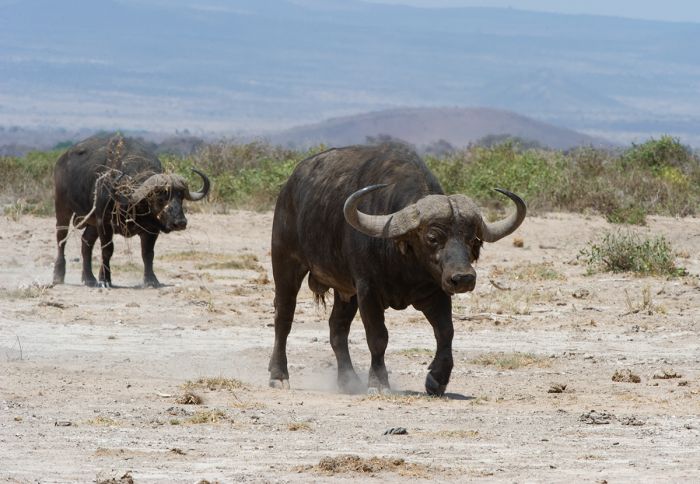
Buffalo bulls in Amboseli (copyright © James Weis).
Grass-eaters are here in abundance, with zebras, giraffes, and buffalos the most common. There are also good numbers of impala, wildebeest, Thomson's gazelle, Grant's gazelle, and the unique gerenuk antelope, with its ultra-long neck. Baboons are here in huge numbers in the areas with trees and around the swamps.
Birding is excellent, especially in the permanent swamps at Enkongo Narok and Ol Okenya and also in the Acacia woodlands. Over 400 species have been recorded in the region.
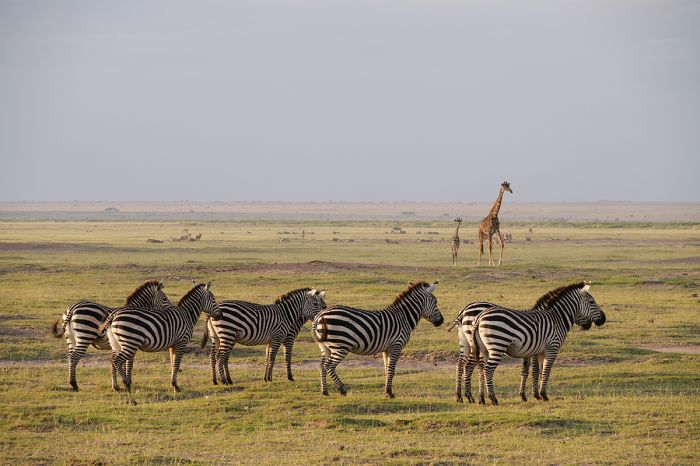
Zebras and giraffes on the Amboseli plains.
During the dry season, much of the wildlife is concentrated into the swamp/marshy regions and into the patchwork of acacia forest for their abundant food sources. After the rains have started, the animals disperse and are much more spread out into the surrounding areas.
The park is small and easily covered in a couple days, but may be worth staying longer to get more chances at great photographs. The marshes have water all year and hippos can be seen at any time.
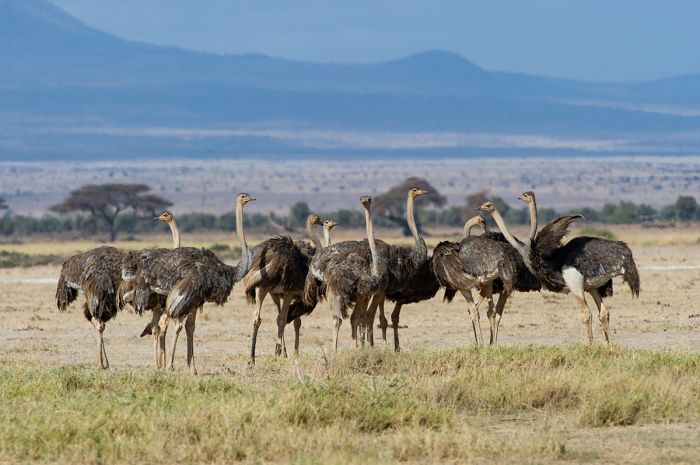
Ostriches are common in Amboseli National Park (copyright © James Weis).
Amboseli Trust For Elephants
The Amboseli Trust for Elephants (ATE) is a research and conservation organization whose aim to to conserve and study Amboseli's elephant population. Supported by the African Wildlife Foundation (AWF), ATE's research is performed by the Amboseli Elephant Research Project (AERP), founded by Dr Cynthia Moss in 1972. AERP is the world's longest-running study of elephants. Since its inception, AERP has monitored and studied all of Amboseli's resident elephants, collecting data on behavior, birth, and deaths.
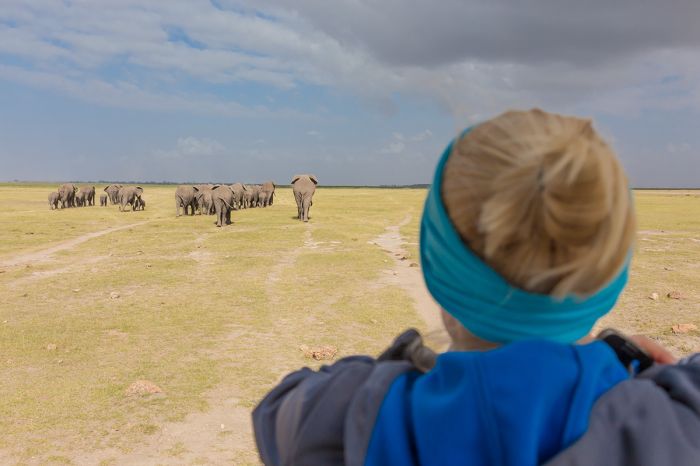
Amboseli is one of the best places in the world to observe elephants.
Africa's elephant population has plummeted since the arrival of Europeans in the 1800s, when the lucrative ivory trade began. The slaughter of Africa's elephants has continued even in recent times, with numbers dropping from an estimated 1.3 million in 1979 to about 600 000 in 1990. Kenya's elephant numbers dropped from around 130 000 in 1973 to 20 000 in 1990 (a loss of 85%). The reason is still primarily due to the world demand for ivory.
Amboseli's elephants have mostly been spared this sad decline. Apart from providing huge gains in our understanding of elephant communication and society, the ongoing presence of AERP's presence in Amboseli has protected its elephants from poaching and persecution over the last 45+ years.
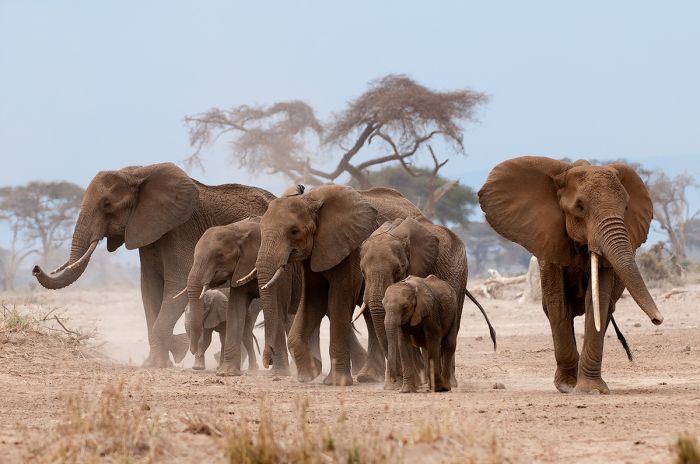
Elephants in Amboseli during the dry season.
When elephants are killed for their ivory, it is the older bulls and cows that are targeted, as they have the largest tusks. This has greatly reduced the number of older elephants in much of Africa and skewed the age structure of the overall population. Due to the protection Amboseli's elephants have been afforded, it is one of the best places in Africa to see older bulls and matriarchs.
Moreover, Amboseli's elephants have become habituated to the presence of the researchers and vehicles, allowing tourists to get up close observation of the hundreds of elephants that live in the park.
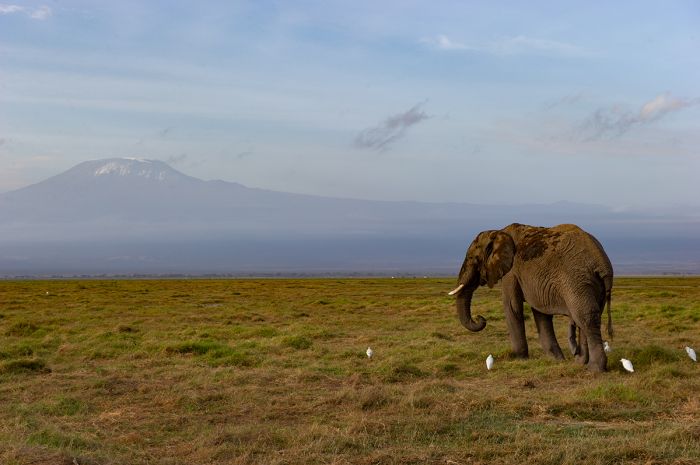
A lone bull elephant with Kilimanjaro in clear view (copyright © James Weis).
Chyulu Hills
Chyulu Hills National Park and its surrounding group ranches offer an amazing, off the beaten path, wild experience in some of Kenya's least visited, but most beautiful country.
Gazetted in 1983, the park covers an area of 182 square miles (471 sq kms) of rolling hills covered in rich grassland with occasional patches of trees. The lava ridge that forms the hills spans around 60 miles (100 kms) in length and was only created recently (~ 500 years ago), and the hills are lush and home to diverse wildlife. The high point on the ridge reaches an elevation of 7 180 feet (2 188 meters).
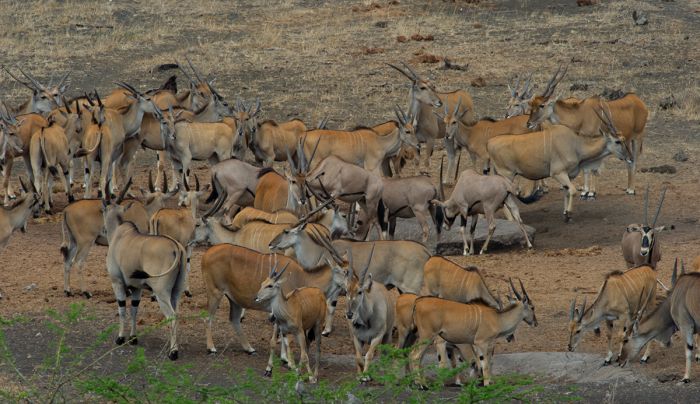
Eland and oryx at a Chyulu Hills waterhole (copyright © James Weis).
Game drives and horseback riding are a specialty in the Chyulus. Some of Kenya's last mega-tusker elephants are known from this area. The tops of the hills are covered in verdant cloud forest and are some of the country's most beautiful lands.
While large numbers of wildlife live in the Chyulu's, they are not heavily concentrated and must be searched for on game drives. All of Africa's Big Five (lion, leopard, elephant, buffalo, and rhino) are present, as well as cheetah, giraffe, zebra, and many more iconic species.
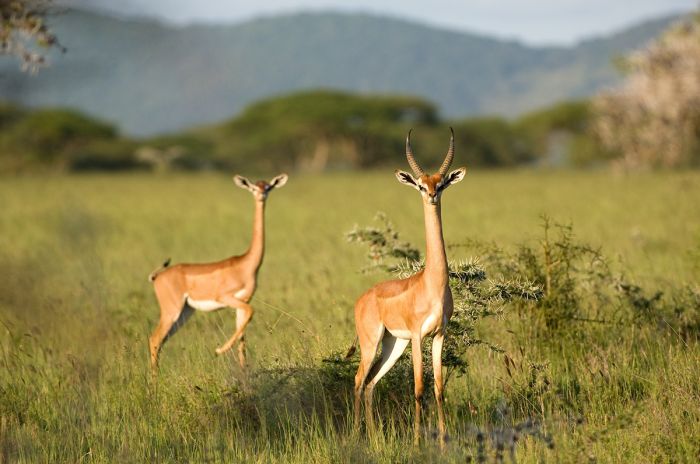
Gerenuk antelopes in the Chyulu Hills region.
Species likely to be seen in the Chyulu Hills include elephant, Burchell's zebra, buffalo, eland, blue wildebeest, oryx, and Masai giraffe. Interesting and less common species that can be seen include bushbuck, mountain reedbuck, gerenuk, and giant forest hog, which is sometimes spotted in the forested areas.
Predators that are possible, but not often seem include lion, leopard, spotted hyena, black-backed jackal, and cheetah. A small population of black rhino exists under constant surveillance by the Kenya Wildlife Service.
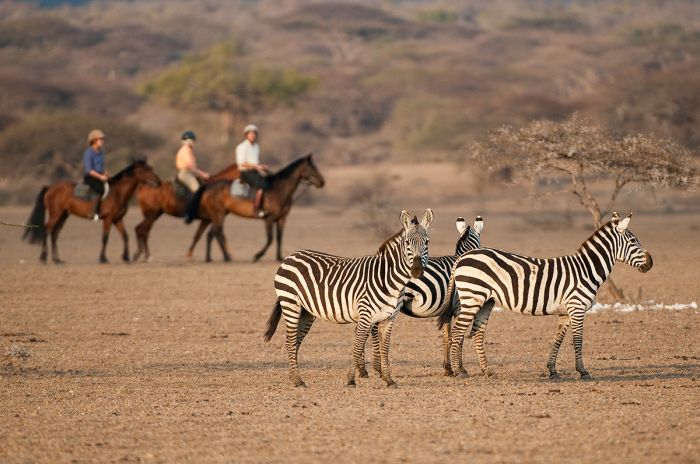
Horseback riding in the Chyulu Hills.
Selenkay Conservation Area
Located north of Amboseli is the Selenkay Conservation Area. The Conservancy covers 60 square kilometers and has a safari camp, which is jointly operated with the local Maasai community. Game drives in the rather bushy area will usually bring views of predators, elephants, and lots of general game. Safari walks are also offered. The area is much less visited and far more wild than Amboseli National Park.
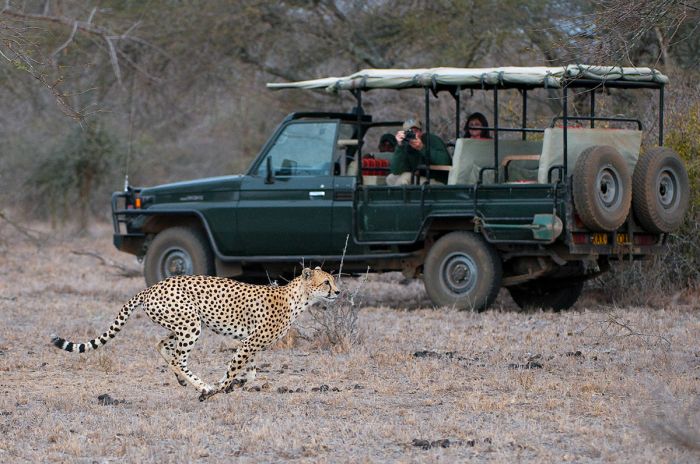
A cheetah seen on game drive near Amboseli, Kenya.
Read More...
Amboseli National Park, Amboseli Trust for Elephants, Chyulu Hills, History, Selenkay Conservation Area, Wildlife
Great Good Fair Poor
- Jan
- Feb
- Mar
- Apr
- May
- Jun
- Jul
- Aug
- Sep
- Oct
- Nov
- Dec
GENERAL TIPS
Amboseli is a very good destination for much of the year, but the recommended time is during the dry months between June and October and again in January and February. This said, visiting Amboseli during the rainy months can also be great if you are lucky with some sunny days, as the marsh areas and Lake Amboseli often become spectacularly good for wildlife viewing when there have been good rains.
The Amboseli region experiences most of its rain between November and May, but there are two somewhat distinct rain seasons, the 'short' rains and the 'long' rains.
The entire area is prone to drought, during which time plants and animals fight for their survival and demonstrate an amazing ability to survive.
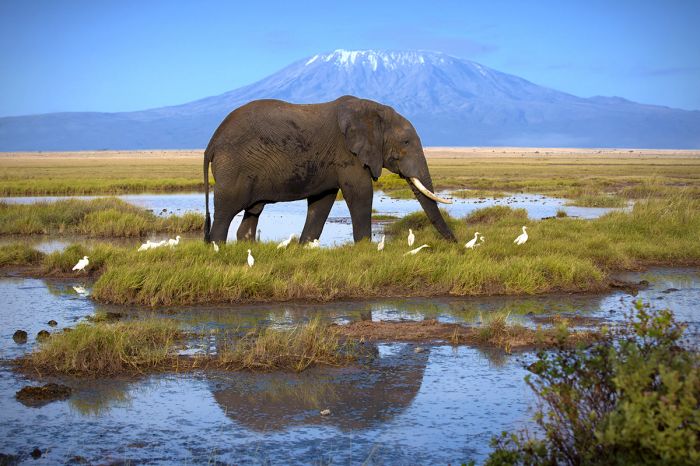
An elephant in Amboseli with Kilimanjaro in the distance.
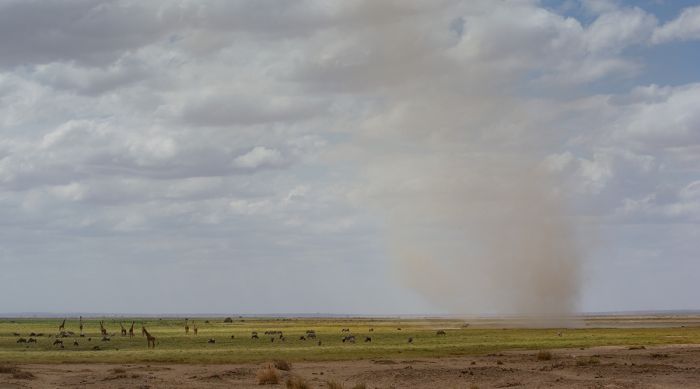
Wildlife on Amboseli's plains with a dust-devil swirling (copyright © James Weis).
Temperatures
The temperatures in the Amboseli region do not have great variation throughout the year, as it lies only 2-3 degrees south of the equator. In general, daytime temperatures are comfortably warm and overnights and early mornings are chilly. Bring a fleece layer regardless of the timing of your visit.
Dry Season
The dry season (June to October) is sunny and warm most days and there is almost never any rain. From June thru August, the afternoon temperature averages 75-79°F (24-26°C), but some days can be warmer. Evenings and early mornings temperatures are often chilly, averaging 57-59°F (14-15°C).
September and October days are very pleasant, with temperatures averaging 80-84°F (28-39°C), with cool mornings persisting, averaging 57-59°F (14-15°C).
During the dry season, Amboseli is an arid, dusty place, with Mount Kilimanjaro covered in heat haze on most days. Despite the dust, photographers will love this time of year, as swirling dust-devils (like miniature tornados) cross the dried plains, sucking clouds of dust hundreds of feet up into the air, making for amazing imagery. Zebras, impalas, giraffes and elephants also kick up dust, making for some incredible imagery. Sunsets during the dry season are also spectacular.
Rainy Season
The rainy season is November through May (read more below) and the temperatures are fairly static throughout the season. Daytime temperatures average 80-85°F (27-29°C) and nighttime and early morning temperatures are cool, but slightly warmer than the dry season, averaging 61-63°F (16-17°C).
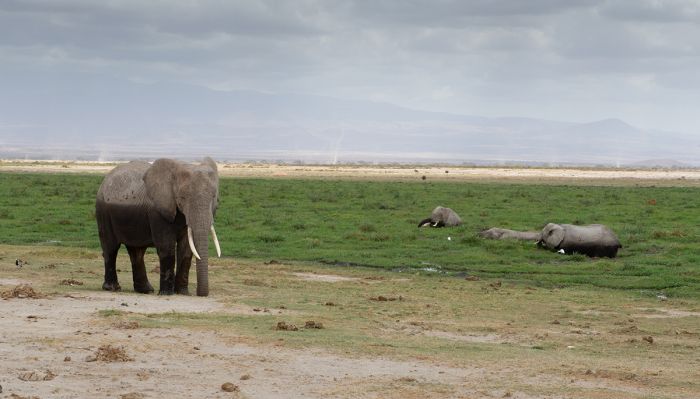
Elephants in the swamp during Amboseli's dry season (copyright © James Weis).
Rainy Season
Short Rains
The short rains occur for about one month sometime during November and December (the exact time varies somewhat year to year). This period is called the 'short' rains because the duration of an individual rain event is short and it is rare to have an all-day rain event. Most rain falls as an afternoon shower, while mornings are typically overcast or clear.
Long Rains
The long rains occur between March and May, with April being the wettest month of the year. During this tome, rain should be expected almost every day and the showers can last for hours at a time, although all-day rain is not typical. The roads in the Amboseli area can become muddy and difficult in places, which can hamper game drives. Cloudy skies are typical and temperatures can be chilly at times.
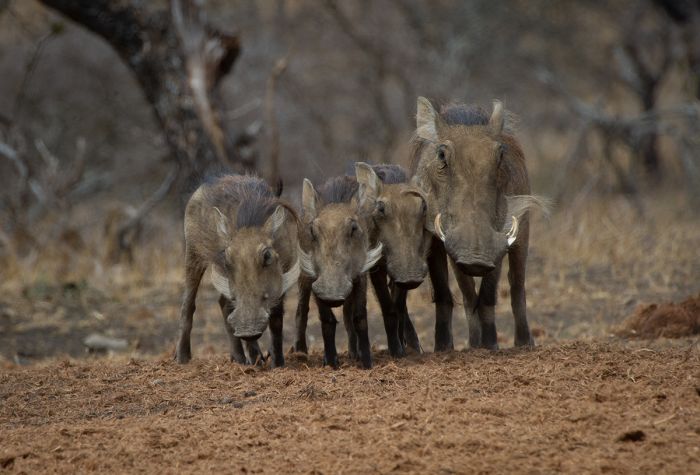
A warthog and her young in the Chyulu Hills (copyright © James Weis).
The period between the short and long rains (January and February) also receives rain, but many days are clear and the amount and duration of the rain events is unpredictable, with some afternoon showers and the odd long and heavy rainfall event.
The rainy season (during good rain years) transforms the national park into a verdant landscape, with Lake Amboseli and other seasonal ponds and lakes partially filled with rain water. These oases of life attract flocks of flamingos, pelicans, and other migratory bird life, creating an amazing spectacle. Some of the elephants and other wildlife disperse into the surrounding areas if the rains have been especially good.
Showing 1–2 of 2 results
Historic lodge located in an huge reserve with very few camps in the picturesque Chyulu Hills. Good wildlife viewing, especially for 'big tusker' elephants. Game drives, horseback riding, walking, mountain biking, two hides at a productive waterhole, cultural visits.…




